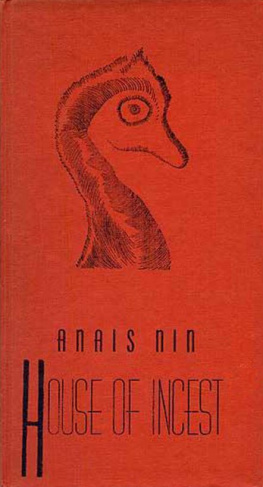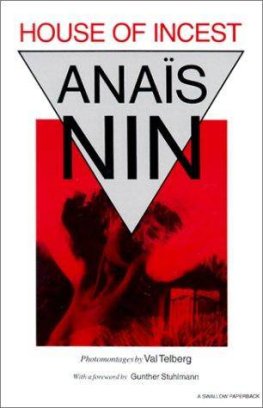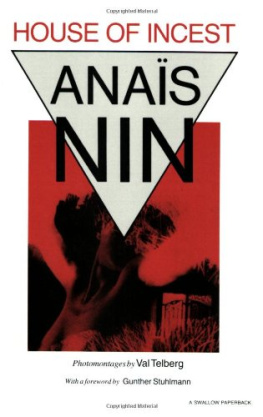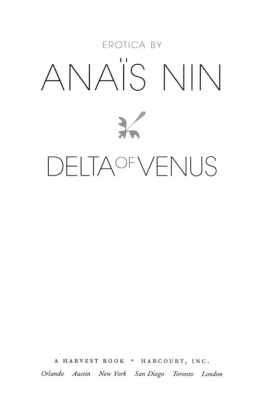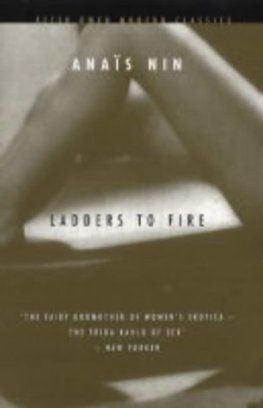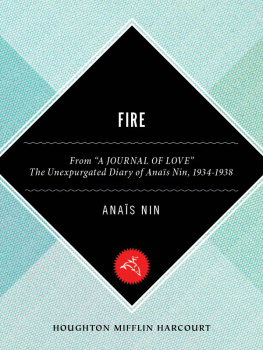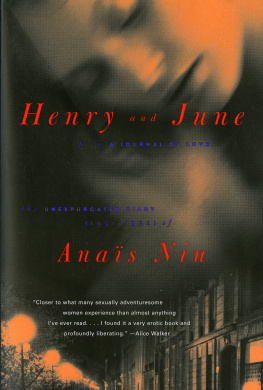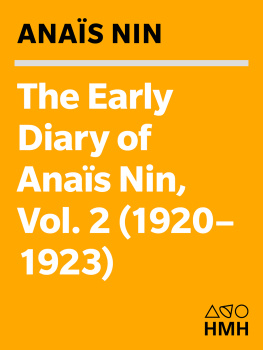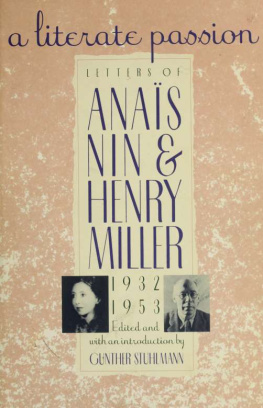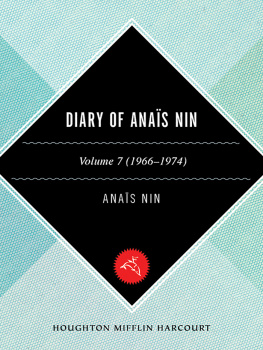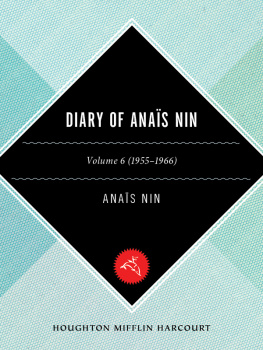Anais Nin - The Diary of Anais Nin, Vol. 1: 1931-1934
Here you can read online Anais Nin - The Diary of Anais Nin, Vol. 1: 1931-1934 full text of the book (entire story) in english for free. Download pdf and epub, get meaning, cover and reviews about this ebook. year: 1969, publisher: Houghton Mifflin Harcourt;Mariner Books, genre: Non-fiction. Description of the work, (preface) as well as reviews are available. Best literature library LitArk.com created for fans of good reading and offers a wide selection of genres:
Romance novel
Science fiction
Adventure
Detective
Science
History
Home and family
Prose
Art
Politics
Computer
Non-fiction
Religion
Business
Children
Humor
Choose a favorite category and find really read worthwhile books. Enjoy immersion in the world of imagination, feel the emotions of the characters or learn something new for yourself, make an fascinating discovery.
- Book:The Diary of Anais Nin, Vol. 1: 1931-1934
- Author:
- Publisher:Houghton Mifflin Harcourt;Mariner Books
- Genre:
- Year:1969
- Rating:5 / 5
- Favourites:Add to favourites
- Your mark:
- 100
- 1
- 2
- 3
- 4
- 5
The Diary of Anais Nin, Vol. 1: 1931-1934: summary, description and annotation
We offer to read an annotation, description, summary or preface (depends on what the author of the book "The Diary of Anais Nin, Vol. 1: 1931-1934" wrote himself). If you haven't found the necessary information about the book — write in the comments, we will try to find it.
The Diary of Anais Nin, Vol. 1: 1931-1934 — read online for free the complete book (whole text) full work
Below is the text of the book, divided by pages. System saving the place of the last page read, allows you to conveniently read the book "The Diary of Anais Nin, Vol. 1: 1931-1934" online for free, without having to search again every time where you left off. Put a bookmark, and you can go to the page where you finished reading at any time.
Font size:
Interval:
Bookmark:
Edited and with an Introduction by Gunther Stuhlmann
A Harvest Book
The Swallow Press
and
Harcourt, Inc.
San Diego New York London
Copyright 1966 by Anas Nin
Copyright renewed 1994 by Rupert Pole
Introduction copyright 1966 by Gunther Stuhlmann
Copyright renewed 1994 by Gunther Stuhlmann
All rights reserved.
No part of this publication may be reproduced
or transmitted in any form or by any means,
electronic or mechanical, including photocopy, recording,
or any information storage and retrieval system,
without permission in writing from the publisher.
Requests for permission to make copies of
any part of the work should be mailed to:
Permissions Department,
Harcourt, Inc., 6277 Sea Harbor Drive,
Orlando, Florida 32887-6777.
Library of Congress Catalog Card Number: 66-12917
ISBN 0-15-626025-5
Printed in the United States of America
JJ KK
For more than three decades, Anas Nin's monumental diary, or journal, has been the object of much rumor, gossip, and conjecture. Since the early 1930s, when she showed sections of the journal for the first time to some of her close friends and associates in Paris, the word has spread that here was one of the unique literary documents of our century. In an often-quoted article in the English magazine Criterion, in 1937, Henry Miller ventured the opinion that the diary would "take its place beside the revelations of St. Augustine, Petronius, Aboard, Rousseau, Proust." Others, who over the years watched the diary grow to its present state of some 150 volumesadding up to more than 15,000 pages in typewritten transcriptcontributed their share to the growing legend surrounding this remarkable, lifelong undertaking.
Anas Nin herself has often stated that the body of her published, artistic workthe five novels which make up the roman fleuve, Cities of the Interior, and her other books and storieswere merely outcroppings of the diary, and that her real life, as a writer and a woman, was contained in the pages of the journal. "I have a natural flow in the diary," she wrote more than thirty years ago, "what I produce outside is a distillation, the myth, the poem." And after an argument about one of her early works of fiction, she noted in the diary: "Sometimes when people talk to me, I feel that I have done all they ask of me here, in the journal, when they ask me to be authentic, passionate, explosive, etc."
Much of the speculation about this legendary work, no doubt, derived from the fact that Miss Nin, in her intense and multileveled life, moved freely, and sometimes mysteriously, in the cosmopolitan world of international art and society. "Friendships, relationships, and travel," she has said, "are my greatest pleasure. The world I live in, in every city, is that of writers, painters, musicians, dancers, and actors." As a child, born in Neuilly, a suburb of Paris, she had accompanied her famous father, the Spanish composer-pianist Joaquin Nin, on his glamorous concert tours through Europe. As a youngster, she had escaped from the poor gentility of her Danish-born mother's rooming house in New York into the enchanted gardens of her fantasies, and eventually had become an artists' model and, later, a Spanish dancer. As a fledgling writer, she had, in the 1930s, re-entered the intellectual and social climate of Paris, captivated, and influenced, by Proust, Lawrence, and Giraudoux. In 1929, she had settled in Louveciennes, and thereas, after the outbreak of World War II, in her studio on the edges of New York's Greenwich Villagehad provided a gathering place for many "unknown," and often subsequently "famous," creative people. Indeed, the roster of those who appear, at one time or another, in Miss Nin's diary represents an impressive cross-section of the literary and artistic life of the past forty years.
But those who may have set their sights merely upon the usual "exposures" of famous lives, the "tell-all" confessions of an insider, will undoubtedly be disappointed by this long-awaited first publication of a section of Miss Nin's diary. To be sure, Anas Nin writes at length, and often with startling candor, about her relationships, her friends and acquaintances, the "famous" and the "ordinary" people who have crossed her path. She is, indeed, "authentic, passionate, explosive." But her concern is not that of the literary gossip. She does not simply treat us to another "keyhole" view of the literary life.
The true significance, the uniqueness, the "revelation" of her diary is of another kind. Certainly, Miss Nin provides much important and valuable biographical, and autobiographical, detail to our knowledge of an artistic era, she portrays and records with flashing insight people, conversations, events. Yet in the end it does not seem to matter that the struggling writer she befriends is Henry Miller, that the tortured poet who confides in her is Antonin Artaud, the propounder of the "theatre of cruelty," or that Dr. Otto Rank is her psychiatrist. The "revelation" of Miss Nin's diary, essentially, lies in the fact that here, for the first time, we have a passionate, detailed, articulate record of a modern woman's journey of self-discovery.
"What I have to say," Miss Nin writes, "is really distinct from the artist and art. It is the woman who has to speak. And it is not only the woman Anas who has to speak, but I who have to speak for many women. As I discover myself, I feel I am merely one of many, a symbol. I begin to understand women of yesterday and today. The mute ones of the past, the inarticulate, who took refuge behind wordless intuitions, and the women of today, all action, and copies of men. And I, in between..."
Indeed, Miss Nin's diary is more than the whetstone of an emerging writer, though she is always aware of the artistic problem of "what to include, what to tell, how to tell it." It is more than a notebook of ideas, dreams, and experiences, though, as she has stated, much of her conscious literary work is drawn from the pages of the diary. And it is more than a mere record of her days, her conversations, her encounters, though she captures them with vivid immediacy. The diary is the log of her journey through the labyrinth of the self, of her effort to find, and to define, the woman Anas, the real and the symbolic one who balances "between" action and contemplation, involvement and self-preservation, emotion and intellect, dreams and reality, and who sometimes despairs of ever reconciling these disparate elements.
There is an entry in the diary, in the mid-1930s, which may explain not only Miss Nin's attitude to the "outside" worldto the gathering political and economic storms which, much to the dismay of her critics, found no direct reflection in her artistic workbut also the basic, underlying function of the journal itself. "What makes people despair," she wrote, "is that they try to find a universal meaning to the whole of life, and then end up by saying it is absurd, illogical, empty of meaning. There is not one big, cosmic meaning for all, there is only the meaning we each give to our life, an individual meaning, an individual plot, like an individual novel, a book for each person. To seek a total unity is wrong. To give as much meaning to one's life as possible seems right to me. For example, I am not committed to any of the political movements which I find full of fanaticism and injustice, but in the face of each human being, I act democratically and humanly. I give each human being his due. I disregard class and possessions. It is the value of their spirit, of their human qualities I pay my respect to, and to their needs as far as I am able to fulfill them. If all of us acted in unison as I act individually, there would be no wars and no poverty. I nave made myself personally responsible for the fate of every human being who has come my way."
Next pageFont size:
Interval:
Bookmark:
Similar books «The Diary of Anais Nin, Vol. 1: 1931-1934»
Look at similar books to The Diary of Anais Nin, Vol. 1: 1931-1934. We have selected literature similar in name and meaning in the hope of providing readers with more options to find new, interesting, not yet read works.
Discussion, reviews of the book The Diary of Anais Nin, Vol. 1: 1931-1934 and just readers' own opinions. Leave your comments, write what you think about the work, its meaning or the main characters. Specify what exactly you liked and what you didn't like, and why you think so.



